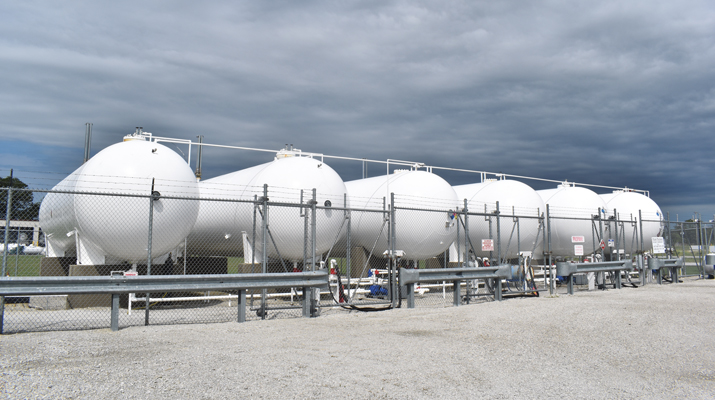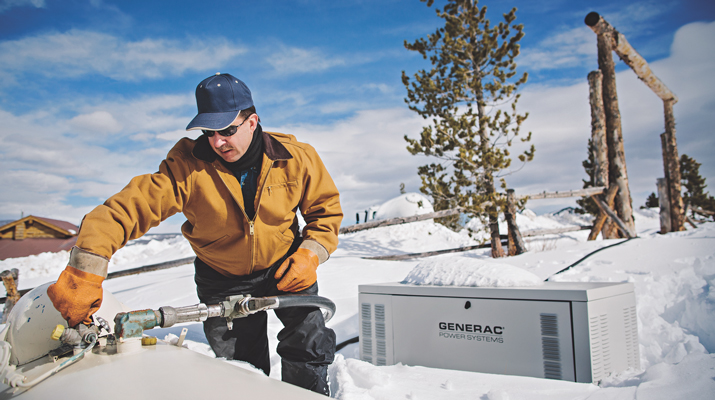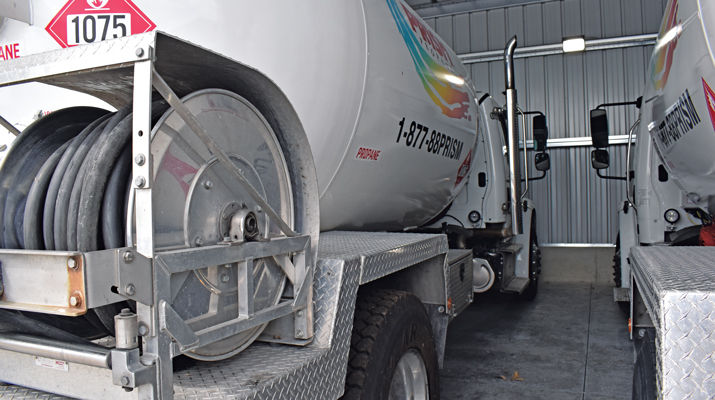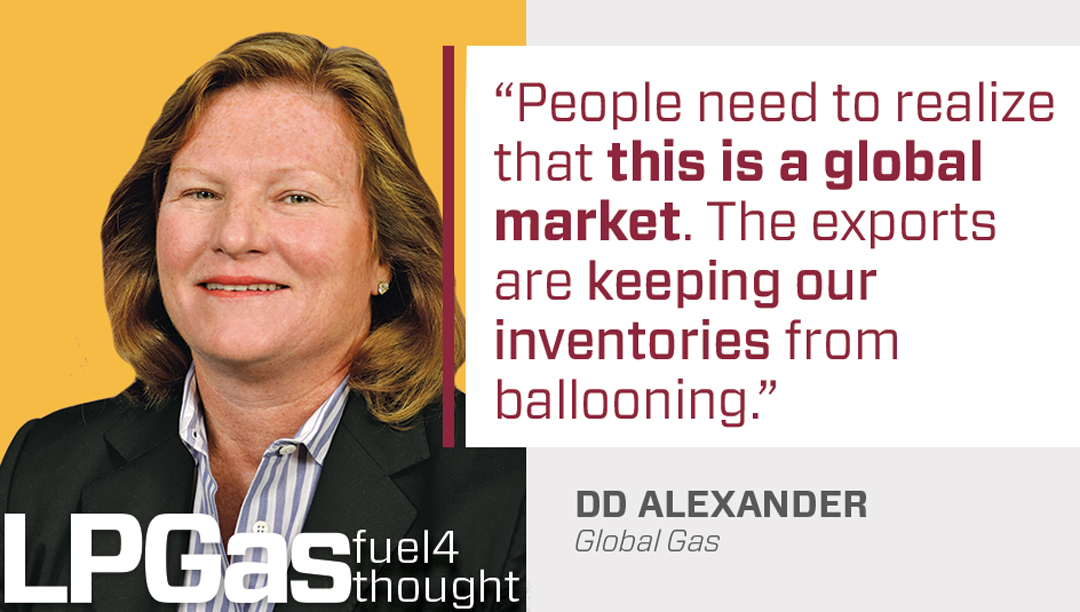Winter preview: Shift in mindset

Unpredictable weather justifies the purchase of business interruption insurance in certain areas. (Photo by LP Gas staff)
Sweltering under an August heat wave, propane retailers were sharpening their pencils and pondering an anticipated solid winter heating season. A nicely proceeding summer build was delivering plenty of cold-weather LPG availability.
In late August, an RBN Energy analysis showed total inventories at 92.3 million barrels, which was nearly 36 percent higher than during the same week last year and 3 million barrels above the five-year maximum.
Amid this solidity, however, comes a caution to “expect the unexpected” as presented by calamities such as floods, landslides, wildfires, blizzards, detoured roads, droughts, staffing scarcities and other logistical headaches. This mayhem could again prove propane’s ability to serve as a reliable fuel to power electrical generators when the grid fails.
Amid Shane Weber’s summertime preparations, “Everything’s pretty solid,” he reports.
“I think we’re going to be OK; we’re open to a cold, cold winter,” says Weber, operations manager at the Matheson Gas location in Erie, Pennsylvania.
Weber’s biggest challenge over the summer was making sure the company’s vehicles were up and running – especially the tank-setting truck, which had to be set aside for repairs.
He expresses confidence that Matheson’s healthy financial condition will enable it to withstand any unexpected expenses.
“Being as large as we are, we don’t see a lot of hiccups: We have buying power, but I don’t know about some of the smaller guys” who might run afoul of rising interest rates and the associated higher operational costs.
“It’s becoming more expensive to run your business,” says consultant Cooper Wilburn at Propane Resources. Dealing with the higher interest rates “is changing what you charge your customers,” he points out, referencing possible pushback from clientele over whatever price increases become necessary.
Plus, there remains the typical surprise of a looming, internal cash crunch that retailers simply don’t see coming.
“Prepare for the unexpected,” Wilburn advises. “Limit your risk.”
Accounting for unexpected crises such as nasty weather, natural disasters, assorted supply shortfalls and other financially dicey costs, Wilburn suggests that retailers consider buying business interruption insurance. Some providers of liability insurance that retailers may have used in the past are getting out of offering that coverage, particularly in areas susceptible to wildfires.
“They’re looking at it like a flood zone,” bearing unbearable liability concerns, “and now it’s a big deal,” he says.

A shortage of qualified drivers and service technicians will continue to challenge propane marketers during the busy heating season. (Photo courtesy of PERC)
Taking the plunge
From an industry-wide perspective, winter’s unpredictability mandates that “we need to be ready to shift gears,” warns Judy Taranovich, president and owner of Vermont’s Proctor Gas, who also sits on the Vermont Fuel Dealers Association board, the Propane Gas Association of New England’s (PGANE) executive board and is the Vermont state director for the National Propane Gas Association (NPGA).
At Proctor Gas, “we always work off the top of our tanks” so that none of the vessels are more than halfway below capacity. Maintaining close relationships with her supply chain is a top priority to ensure product continuity.
“I’m feeling pretty good about our supply and our suppliers,” Taranovich says. “They’ve never let me down.”
Taranovich is an enthusiastic backer of tank monitors. After an initial, successful outlay of 200 units, the company plans to order 1,000 new units to further serve its 3,000-member customer base. Five hundred are being installed this year, with 500 more on tap for next year.
“We took the plunge this year” by committing to the technology, which Taranovich views as a major asset for preventing customers from running out of propane amid New England’s bitter temperatures and deep snow. When low levels loom, “We’ll get back there and get the tanks filled.”
Relentless rain has been falling over the summer. Taranovich imagines the predicament for propane deliveries if that moisture froze, and that’s where the monitors can help us” – by remotely determining which tanks at the rear of steep driveways along icy roads need personal attention.
Patronizing a mobile propane truck repair and inspection service is another hedge against operational interruptions.
Citing a previous incident where some key railroad trestles were washed away by floodwaters, Taranovich remains mindful of chaotic events such as highway closures and other unanticipated business roadblocks that may impact her bottom line.
“That could drastically change our pricing,” she explains, noting that a geopolitical blowup on the other side of the world can bring about similar cascading consequences.
“We’ve never run out of gas in 40 years. We contract for all the gas we think we’re going to need. We’re not spot buyers looking for the lowest price.” –David Gable, Hocon Gas
Building inventory
Maintaining an array of flexible supply plans is the best way to go, according to consultant JD Buss at Twin Feathers Consulting in Overland Park, Kansas.
Looking ahead to next year, setting aside a six- to eight-month supply planning period prior to the first snowfall can be quite beneficial.
“These are not the things that you just slap together,” he says.
While an average crop drying season was in the forecast, “we definitely are anticipating a larger spot market than people were anticipating,” says Buss, reminding retailers to closely monitor rail car availability as the heating season progresses.
Propane’s pricing has been much lower than fuel oil, but the impact of any large number of consumer switchovers in favor of propane is not likely to be felt until next spring.
Because of the complexities and possible homeowner anxiety over altering their heating system apparatus, “you can’t just snap your fingers” in expectation of a rapid shift from fuel oil to propane. “I think it will just be a steady flow” of existing fuel oil customers opting for propane instead, Buss says.
Serving Connecticut, western Massachusetts and elsewhere throughout southern New England, Hocon Gas and its six branches have 36 to 48 hours of stored propane.
LPG is sourced from 10 different locations within the region, including pipelines, rail terminals and refineries in Philadelphia and New Jersey, according to David Gable, Hocon’s owner and president.
“We’ve never run out of gas in 40 years,” he says. “We contract for all the gas we think we’re going to need. We’re not spot buyers looking for the lowest price.”
Hocon does well in obtaining new business, says Gable, a former president of PGANE and previously Connecticut’s NPGA representative. He is pleased about the reduction of lead times for new propane tank deliveries – down to six weeks from the previous lag times of six to eight months.

Measures like a mobile truck repair and inspection service hedge against the unexpected and ensure reliable delivery schedules. (Photo by LP Gas staff)
Dire shortages of drivers and technicians continue to be a critical industry concern, according to Gable.
“Where did they go?” he laments. “They used to be happy to have a steady job with great benefits.”
“We’ll have this issue going forward: Drivers want to work 8-5 and be home every night,” reports DD Alexander, the president of Global Gas, who additionally serves on NPGA’s Executive Committee as well as its Propane Supply & Logistics Committee.
NPGA has been active in hosting seminars and conducting other programs to boost employee recruitment and retention efforts.
“We’re trying to do everything we can to help the drivers in this industry,” she says.
As for the heating season’s pending arrival and this summer’s pre-buying business strategies, “We see a lot of marketers locking in their winter price,” says Alexander.
U.S. propane production and exports are strong. In August, gas plants were driving production to a 2023 average of 1.97 million barrels per day (bpd), while exports were averaging 1.54 million bpd after reaching a record of 1.7 million bpd in March, according to RBN Energy.
“People need to realize that this is a global market,” Alexander says. “The exports are keeping our inventories from ballooning.”
And America’s domestic winter preparations are solid.
“People are building inventory. We have a lot of inventory at the hubs,” says Alexander. “It gets down to logistics, logistics, logistics. Is the propane where we need it to be?”
Closing in on 100
In late August, an RBN Energy analysis showed total U.S. propane inventories at 92.3 million barrels, 36 percent higher than the same week last year. According to the U.S. Energy Information Administration, U.S. propane inventories reached a high of nearly 103 million barrels in November 2015.

Winter preparedness resources
⦁ The Propane Education & Research Council (PERC) provides propane marketers with important information on how to plan for the winter. PERC hosted a webinar on winter preparedness, part of its “Propane Presents Technology Series,” in August. Attendees learned about the resources PERC has assembled to prepare customers for the winter. Visit propane.com to access the webinar as well as to view all of PERC’s winter preparedness resources for propane providers.
⦁ Similarly, RBN Energy hosted a webinar focused on preparing for winter propane demand. NPGA shared a link to the webinar in its member events and news section. RBN provides a weekly supply update for the association.
⦁ Beginning in October, the U.S. Energy Information Administration will start its weekly heating oil and propane update of residential and wholesale prices.
⦁ Cost Management Solutions also offers its weekly Trader’s Corner newsletter, an in-depth analysis of the propane market, through a partnership with LP Gas.
Related:
















